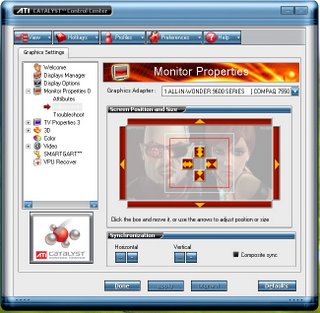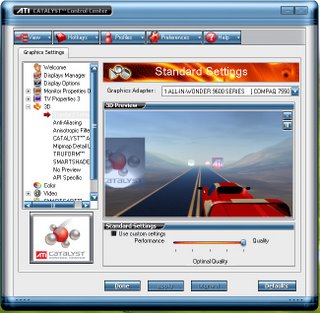After 6 months, I'm ready to complain. I don't want to be overly negative -- this card definitely improved in-game graphics (I'm now at "average" game graphics settings instead of "low"), but there are some things that BUG ME about the software.
What's in the box:
-The ATI All-in-Wonder AGP Card (which has 1 coaxial input for TV)
-A "domino" that connects 1 stereo audio, 1 composite video, and 1 S-video input. (Yes, it looks like a big domino, because they thought it was cool)
-A manual with instructions on how to install everything (which I followed exactly)
-A lot of software including "Catalyst" drivers, the ATI Multimedia Center, some video editing toys, and a "bonus DVD" that I still haven't gotten around to looking at.
Okay, first complaint: why only 1 audio, and 2 video inputs? How can I attach my VHS player, DVD player, digital camera, and stereo all at the same time? My 1997 Sony VAIO had just as many. And I am constantly having to swap out cables, which is annoying when there are so many -- it's easy to get confused. Also, there aren't any audio outputs on the card, you have to rely on the standard mini-jack output built into your motherboard (and there's only one). I split mine to go both to the computer speakers and back to the TV, but this causes a serious reduction in audio integrity. Again, I have to do some fancy cable-switching to plug in headphones. Additionally, there are 1 VGA out, 1 S-video out, and 1 component video out -- no coax-out (which would be more useful for output to a TV because the audio is included in the signal, reducing wire clutter, and would free up the mini-jack for computer speakers).
Second complaint: I mentioned this before in my first blog post, but it's so annoying that it deserves a repeat... after installing this card, my Windows start up time when from a tolerable few seconds, to an annoying -- no incredibly annoying -- 4 minutes (sometimes more). It's so annoying that I'd rather pay an extra $10 a month in electric bill than to turn my computer off at night and have to wait for it to restart in the morning. Unfortunately, the ATI software tends to get confused and stop displaying video images after a while, thus forcing me to restart anyway. I tried to optimize the start up, and remove unecessary programs, but this caused major errors, and I had to go back to a restore point.
Third complaint: After installing the software my Windows start up screens are all offset (about 1/4 of the screen is out of view), and sometimes they are plagued by wavey lines. But once it gets to the Windows profile screen, everything is fine. Just hope I don't want to do anything in the BIOS anytime soon.
Now for a walk-thru of the included software and drivers:
The Catalyst Control Center: The Catalyst version that is included in the box is version 1.2.something. A quick check of ati.com shows that they are up to version 6.4 already (the new version will be investigated in a future blog post).
 | (The Welcome Screen) Under Preferences you can change the look of Catalyst (I chose blue because it's pretty). The Welcome screen has a link to driver updates, otherwise nothing useful. |
 | (Display Options Screen) I haven't found a use for this screen yet. When I had trouble getting the software to detect the TV, I tried to force its detection here, but that didn't work at all. |
 | (Monitor Properties Screen) This is where you adjust the horizontal and vertical stretch and position. |








Great arcticle/ review thingy.... And quite an affordable Wonder that is.
ReplyDelete